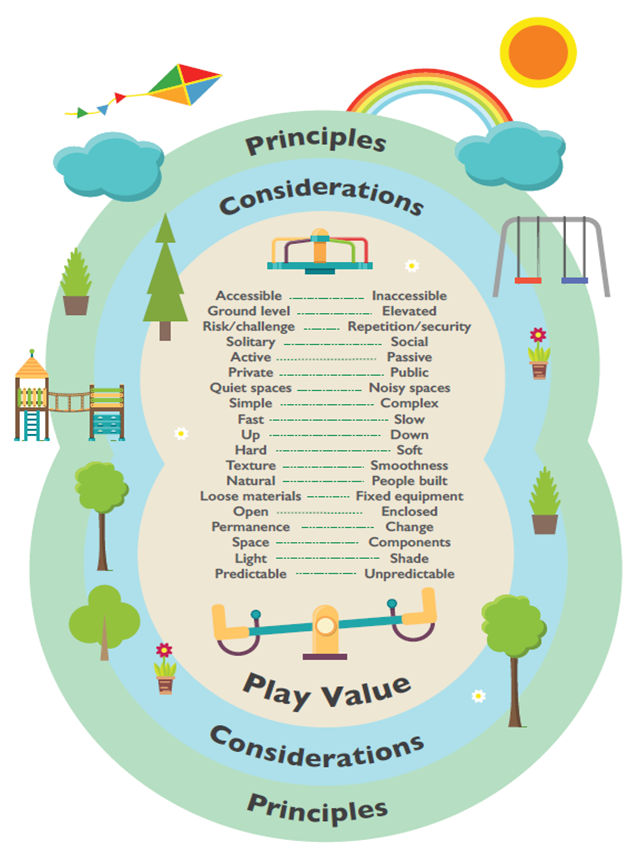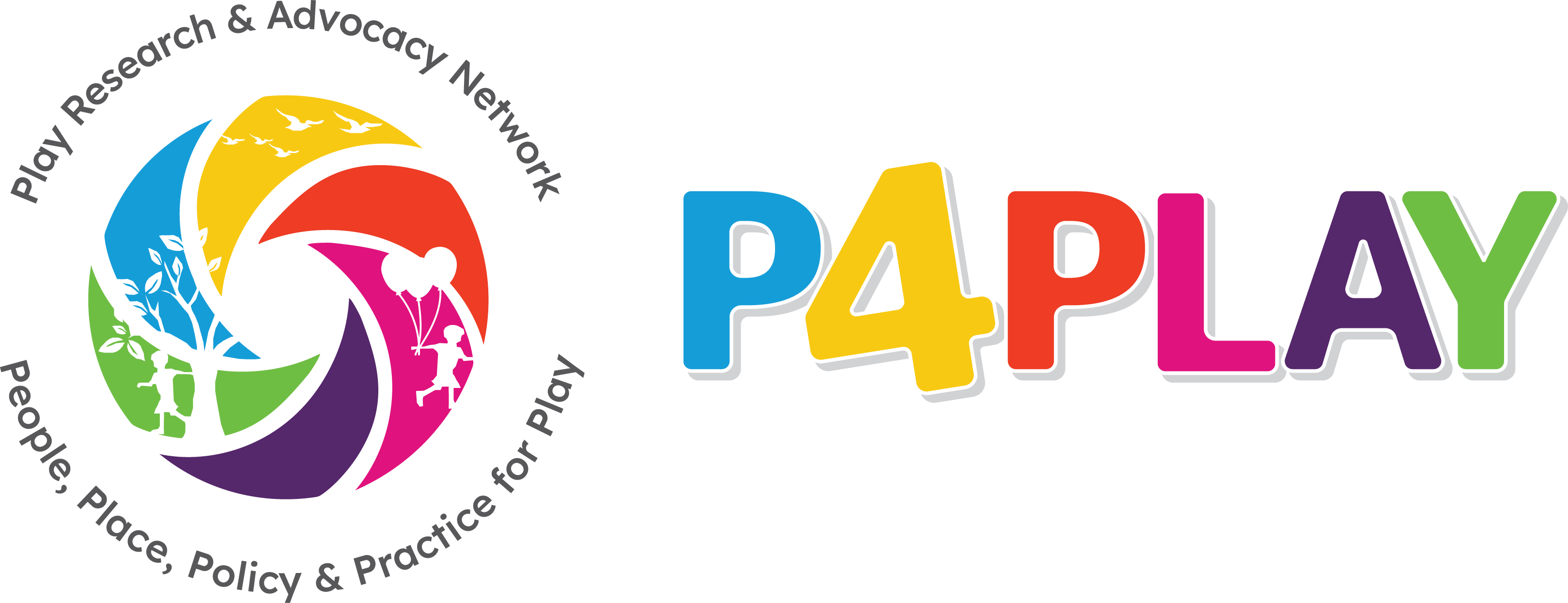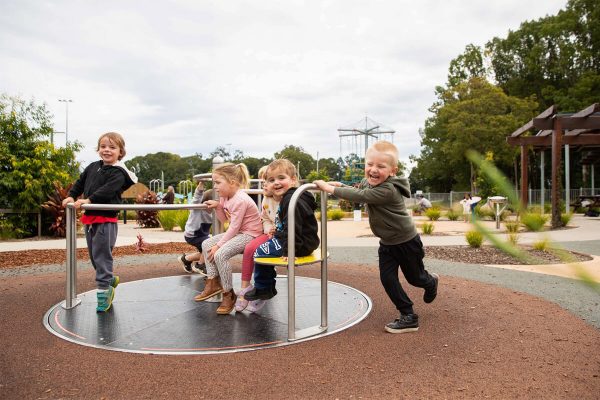Where to Begin When Planning for Playspaces: Design by Inclusion and Inclusion by Design

An integrated model of play provision
The Playability Model (Lynch & Moore, 2018) is one way of approaching playspace design to capture the key principles, considerations, and play value factors in the design and development of Universal Design playspaces (see Playability Model, Figure 1).
The model is derived from a synthesis of the review and analysis of literature, policy and guidelines (NDA report 2018).
The Playability model comprises three tiers that interact and compete with one another in the design and development of quality playspaces. Modifying playgrounds to meet accessibility requirements, or only providing adult-led ‘play’ opportunities, does not promote play value and is not what we are aiming for. Instead, play value is at the centre, and achieved by careful design guided by 8 core principles, and key considerations.
The Committee on the Rights of the Child (CRC, 2013) highlights play as a ‘fundamental and vital dimension of the pleasure of childhood’. As such, play value takes precedence in this model. It is identified as an essential consideration in the design and development of quality playspaces.
Addressing Play value
It is difficult to specifically explain how to achieve play value as playspaces need to be flexible and offer varied simple and complex play opportunities if it seeks to meet the needs of all children who wish to play there. In 2008, Helen Woolley cited Stine’s work to provide some guidance on how we can expand our thing beyond listing types of play equipment (1997):
‘The need for more complex spaces for play has also been suggested by Stine as being an issue of providing for a series of dichotomous relationships: including being accessible and inaccessible, active and passive, challenge/risk and repetition/security, hard and soft, natural and people built, open and closed, permanence and change, private and public, simple and complex’ (Stine, as cited in Woolley, 2008, p. 12).
This identification of dichotomies as a way to capture play value was applied in our research and Stine’s dichotomies were expanded upon, to include other characteristics that arose in the guideline review, such as, fast and slow, space and components, solitary and social, predictable and unpredictable, quiet spaces and noisy spaces, light and shade, predictable and unpredictable, loose material and fixed material, texture and smoothness, ground level and elevated (Playability Model, Figure 1).
See how Woolley described the problem of KFC playgrounds, where the same Kit, Fences and Carpets are used, resulting in low play value and unused places for play: Exploring the Relationship between Design Approach and Play Value of Outdoor Play Spaces – White Rose Research Online
Figure 1. Playability Model: Integrating principles, considerations and play value for good practice in Universal Design play provision (Lynch & Moore, 2018)

Eight overarching principles
In our work exploring playground design guidelines internationally as well as in Ireland, we identified EIGHT CORE PRINCIPLES to guide inclusive planning and play provision in community parks and playspaces in Ireland.
In these 8 core principles, the design and development of playspaces is underpinned by core principles related to children’s rights and social policy concerning protection and promotion of rights and designing for inclusion, and children’s participation in decision-making at the centre. The application of Universal Design underpins these 8 overarching principles as guided by the General Comment no 17 on the right to play (2013)
Community playspaces should be designed with the following 8 principles in mind
- Principle 1: A rights-based perspective, underpinned by inclusive social policy
- Principle 2: Respect for diversity of age, gender, size, ability, socioeconomic, ethnicity and cultural differences
- Principle 3: Intergenerational spaces: Incorporating amenities as well as play opportunities
- Principle 4: Play value
- Principle 5: Positive approach to risk and challenge in policy and provision
- Principle 6: Design by inclusion: Involving users in the design process
- Principle 7: Inclusion by design: Universal Design
- Principle 8: Designed for inclusion but 100% accessibility and usability is not the goal
Core considerations
Planning and designing for inclusive community playspaces also require the need to attend to core considerations.
In the review of guidelines, core considerations were identified that commonly arise in playground planning and provision among municipalities, that related to pragmatic planning and design factors at local policy, planning, provision levels.
There are numerous competing factors and/or priorities in the design and development of Universal Design playspaces that offer significant play value. These included factors such as: location, size, storage, free access, maintenance, vandalism, fencing, surfacing, play sufficiency, capacity building of parks and playground staff.
Community parks and playspaces should be designed with the following considerations in mind
- Free access/ Entrance fee: If an entrance fee is applied, this may exclude low-income families. Yet a small fee can help towards maintenance costs.
- Maintenance/ Vandalism: Maintenance costs can include a considerable commitment to repairing vandalism in some areas. Strategies to address vandalism are important considerations to help reduce maintenance costs.
- Fencing: While open spaces contribute to maximum access, the lack of fencing can reduce usability for children who have a poor sense of danger.
- Surfacing: Protective surfacing in playspaces can reduce the play value, whereas natural surfacing (such as grass or sand) can increase it. A variety of surfacing should be considered to maximise accessibility and play value.
- Play sufficiency: In each geographical region, it is important to assess play sufficiency, to ensure adequate local provision of parks and playspaces. The Irish Play Policy (2004) establishes the need for local authorities to conduct national play sufficiency assessment.
- Cost-effective design: Designs that maximise universal design do not need to be costly – consider low costs solutions, including the use of natural terrain, planting and play value.
- Capacity building: Consider providing guidance and education (Universal Design, play and play value) to all stakeholders who are involved in designing and providing parks and playgrounds.
- Inter-professional working: Professionals who work in parks and playground design and provision come from varied sectors including design, landscape architecture, engineering, horticulture, play-workers and occupational therapy.
- Flow/ Layout: Layout within a park and playspace contributes to usability – consider contrasting surfaces and pathways through a playspace.
- Segregation/ No segregation: Intergenerational use can be maximised by removing segregated areas in playspaces. However, some children (for example, toddlers) like to stay close to adult carers, so having play components for younger users positioned in one area can help maximise play value.
- Local policy for inclusion: Establish an overall policy for inclusion that incorporates parks and playgrounds in addition to other public amenities; this should include a process of engagement with users.
- Play component selection: Selection should be based on play preferences of users, including those with diverse abilities, ages, size and gender.
- Ground level/ Elevated: A mix of ground level and elevated components is important, alongside play value and Universal Design considerations for accessibility and usability.
- Making the ‘cool’ piece most accessible: Although not all components can be designed using a Universal Design approach, it is important to prioritise access for the most valued play components in the playspace.
- Location: This may be predetermined or chosen. Either way, maximise design features based on location.
- Character: Include assessment of character of the local terrain, community context and location as part of the design process.
- Meeting the needs of the community: Involve varied community representatives to determine community needs and inform the design process.
- Funding: Establish a source of funding for immediate design and for long term development and maintenance.
- Sustainability: Plan for long-term maintenance and development.
- Size: Consider whether the size is adequate for current or future needs. Expansion plans to increase size may be required.
- Storage: Play value is maximised when there are loose parts such as spades, buckets and ropes are available. Such items will need to be stored when not in use.



